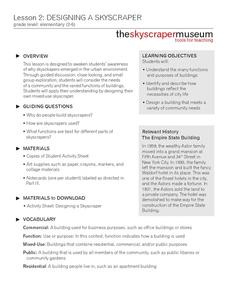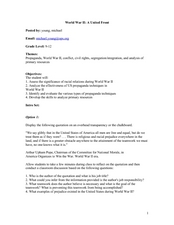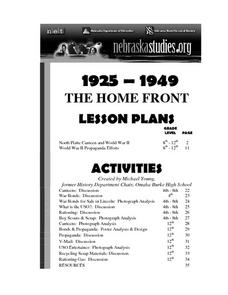PBS
Eleanor Roosevelt: First Lady, Diplomat, and Activist
Scholars analyze the impact Eleanor Roosevelt had on not just the nation, but also on the world. Primary sources and video clips help form a picture of the First Lady and her accomplishments. As a final activity, individuals create...
Teaching Tolerance
Understanding the Prison Label
Break the chain. An engaging lesson plan examines why it is so hard to break free of the prison system in the US. Academics participate in a reader's theater, read primary sources, and discuss their thoughts. The lesson plan explains the...
Curated OER
Watershed Documentary
Students conduct research and collect data about a local watershed area. They create an iMovie showing the human and natural impacts on the creek and watershed areas.
Curated OER
Beautiful Bovine
Students compare and contrast a human body to a cow. Using a diagram, they label and identify the functions of the cow's numerous parts. In groups, they create a Venn Diagram to compare the various types of cows with one another. They...
Curated OER
Rights and Responsibilities in History
Students research rights and responsibilities in historic themes using primary source documents. They produce an iMovie including appropriate images and sounds.
Curated OER
From George to Martha: Writing a Sonnet Using Primary Sources
What was the relationship like between George and Martha Washington? To protect their privacy, Martha Washington destroyed all her husband’s letters after his death so historians have little evidence of their lives together. Two letters...
National Endowment for the Humanities
The Rise and Fall of Joseph McCarthy
"I have here in my hand . . ." The war against Communism and Joseph McCarthy’s place in it are the focus of a series of lessons examining postwar America from 1945-1954. Joseph McCarthy takes center stage in this, the final lesson...
Facing History and Ourselves
Justice After the Holocaust
Though there could be no true justice for the horrors of the Holocaust, many of those responsible for crimes against humanity were found guilty in the eyes of the law. Using primary and secondary sources in the 16th installment of a...
New York State Education Department
Global History and Geography Examination: January 2013
How much do high schoolers know about human history? The assessment covers global history and geography with multiple choice, document based items, and essay questions. It covers topics such as human migration patterns and religions of...
Reading Through History
The March on Washington
How does marching get a point across to the government? Teach pupils about civics, human rights, and freedom of speech using the resource about the March on Washington. After reading, learners complete multiple-choice and short-answer...
Skyscraper Museum
Designing a Skyscraper
Besides serving as awe-inspiring monuments of human achievement, skyscrapers are built to perform a wide range of functions in urban communities. The second lesson in this series begins by exploring the history of the Empire State...
Curated OER
Stitching Truth Lesson Two: The Arpilleristas in Pinochet's Chile
Students analyze arpilleras. In this Chilean history instructional activity, students examine social justice issues as they read and interpret arpilleras. Students study the tapestries to learn about Augusto Pinochet and his human rights...
Curated OER
Leaving Home for the West - Why?
Learners examine primary sources regarding American movement to the west. For this westward expansion lesson, students create broadside posters based on the Homestead Act primary sources they research.
Curated OER
Lesson Plan on Girls' Education
Students examine the obstacles in education faced by young girls in developing countries. Through discussion, they explore what international documents protect this basic human right.
Curated OER
Visions in the Dust: A Child's Perspective of the Dust Bowl
Students examine primary source material of the Depression to correlate the fictional text "Out of the Dust" with actual visual, auditory, and manuscript accounts as found in the American Memory collections.
Curated OER
Immigrant Photo Analysis
Students examine photographs taken of immigrants during late 1800s and early 1990s in America, and identify factors involved in immigration through examination of primary documents that include statistics, trends, graphs, photographs,...
Curated OER
Roads to Refuge: Refugees in Australia
Students identify terms asylum seeker, refugee and migrant, and discuss differences. Students examine significance of persecution in refugee context, explore concept of human rights and discuss some key articles from Universal...
Curated OER
World War II: A United Front
Students interpret historical evidence presented in primary resources. In this World War II lesson, students examine racial relations during the war and then examine propaganda techniques employed by the United States...
Curated OER
North Platte Canteen and World War II
Students employ primary resources to investigate the rise and decline of a canteen in World War II. The significance of volunteerism and the use of the railroad for troop transportation are examined.
Curated OER
The Most American Thing in America: The Chautauqua
Students explore the Chautauqua movement. In this Pennsylvania history lesson, students use primary documents to explore what the Chautauqua was and how it made a difference in the American way of life.
Curated OER
Painting a Neighborhood
Students explore the concept of neighborhoods and identify primary and secondary colors. In this colors and community lesson, students read the book Harold and the Purple Crayon and then discuss the concept of a neighborhood. Students...
Curated OER
Transcription of the Virginia Declaration
In this teaching primary resources worksheet, students read a transcription of the Virgina Declaration . Students read the excerpt and discuss its significance.
Facing History and Ourselves
What is Justice After Genocide?
High schoolers explore the meaning and implications of genocide. In this human rights lesson, students investigate the Aremenian genocide that took place in Turkey and the subsequent trials of the leader of the...
Amnesty International
Hotel Rwanda Teacher's Guide
Here is the comprehensive, official educator's guide for presenting Hotel Rwanda and the story of the Rwandan genocide in 1994 to a classroom environment. It includes a range of exceptional hands-on or discussion activities, as well...























